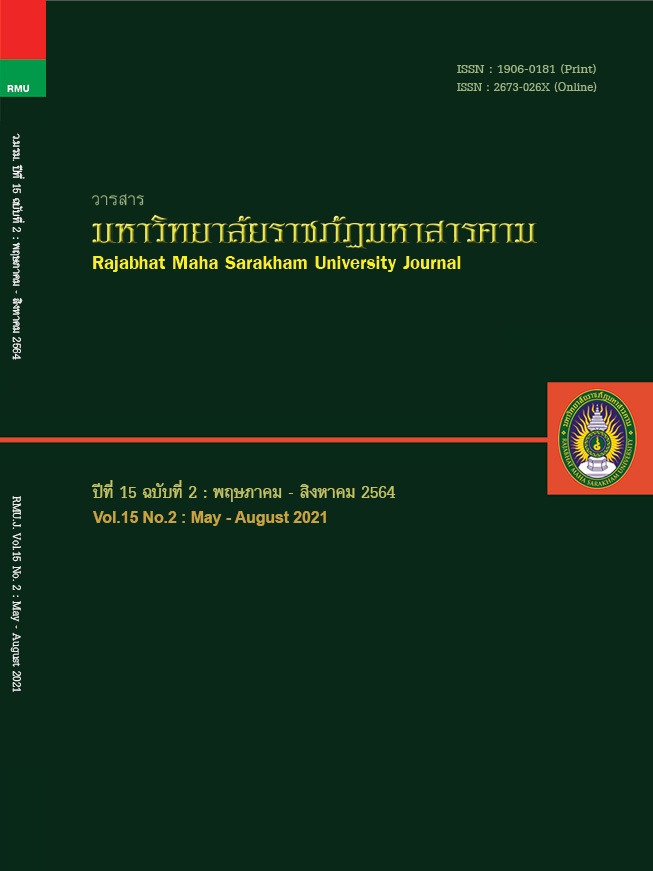การพัฒนากิจกรรมการเรียนรู้คณิตศาสตร์แบบสร้างสรรค์เป็นฐาน (CBL) ร่วมกับการบูรณาการ เทคโนโลยีในการสอนเนื้อหาวิชาเฉพาะ (TPACK) เพื่อพัฒนาผลสัมฤทธ์ิทางการเรียนและการคิดสร้างสรรค์ทางคณิตศาสตร์ เรื่อง วงกลมของนักเรียนชั้นประถมศึกษาปีที่ 6
Main Article Content
บทคัดย่อ
การวิจัยครั้งนี้มีจุดมุ่งหมาย1)เพื่อพัฒนาแผนการจัดกิจกรรมการเรียนรู้คณิตศาสตร์แบบสร้างสรรค์เป็นฐานร่วมกับการบูรณาการเทคโนโลยีในการสอนเนื้อหาวิชาเฉพาะเรื่อง วงกลมชั้นประถมศึกษาปีที่ 6 ที่มีประสิทธิภาพตามเกณฑ์ 75/752) ศึกษาค่าดัชนีประสิทธิผล 3)เปรียบเทียบผลสัมฤทธิ์ทางการเรียนของนักเรียนกับเกณฑ์ร้อยละ 754) เปรียบเทียบความสามารถในการคิดสร้างสรรค์ทางคณิตศาสตร์ของนักเรียนกับเกณฑ์ร้อยละ 75 และ5) ศึกษาความพึงพอใจที่มีต่อการจัดกิจกรรมการเรียนรู้ข้างต้นโดยกลุ่มตัวอย่าง คือ นักเรียนชั้นประถมศึกษาปีที่ 6 โรงเรียนบ้านดงหวาย จังหวัดร้อยเอ็ดจำนวน 1 ห้องเรียนทั้งหมด9 คน ซึ่งได้มาโดยวิธีสุ่มแบบกลุ่ม เครื่องมือที่ใช้ในการวิจัย ได้แก่แผนการจัดกิจกรรมการเรียนรู้คณิตศาสตร์แบบสร้างสรรค์เป็นฐานร่วมกับการบูรณาการเทคโนโลยีในการสอนเนื้อหาวิชาเฉพาะจำนวน18แผน แบบทดสอบวัดผลสัมฤทธิ์ทางการเรียนแบบปรนัยเลือกตอบ จำนวน 15 ข้อ และแบบอัตนัย จำนวน 1 ข้อ มีค่าดัชนีความสอดคล้อง ตั้งแต่ 0.80-1.00 ค่าความยากตั้งแต่ 0.25-0.80 ค่าอำนาจจำแนกตั้งแต่ 0.21-0.92 ค่าความเชื่อมั่นทั้งฉบับเท่ากับ 0.99 แบบทดสอบความสามารถ
ในการคิดสร้างสรรค์ทางคณิตศาสตร์ แบบอัตนัย จำนวน 4 ข้อ มีค่าดัชนีความสอดคล้องเท่ากับ 1.00 ค่าความยากตั้งแต่ 0.30-0.42 ค่าอำนาจจำแนกตั้งแต่ 0.28-0.50 ค่าความเชื่อมั่นทั้งฉบับเท่ากับ 0.87 และแบบวัดความพึงพอใจต่อการจัดการเรียนรู้ จำนวน 20 ข้อ มีค่าความเที่ยงตรงเชิงเนื้อหาเท่ากับ1.00สถิติที่ใช้ในการวิเคราะห์ข้อมูล ได้แก่ ร้อยละ ค่าเฉลี่ย ส่วนเบี่ยงเบนมาตรฐาน และทดสอบสมมติฐานโดยใช้ t-test for One Sample
ผลการวิจัยพบว่า แผนการจัดกิจกรรมการเรียนรู้คณิตศาสตร์แบบสร้างสรรค์เป็นฐานร่วมกับการบูรณาการเทคโนโลยีในการสอนเนื้อหาวิชาเฉพาะ ประกอบด้วย 5 ขั้นตอน ได้แก่ กระตุ้นความสนใจตั้งปัญหาและแบ่งกลุ่มตามความสนใจค้นคว้าคิดนำเสนอและประเมินผล ซึ่งประยุกต์การบูรณาการเทคโนโลยีในการสอนเนื้อหาวิชาเฉพาะในขั้นที่ 3และ 4 มีประสิทธิภาพ 87.15/83.89 และค่าดัชนีประสิทธิผลเท่ากับ 0.7898 แสดงว่านักเรียนมีความก้าวหน้าเพิ่มขึ้นร้อยละ 78.98 อีกทั้งนักเรียนที่เรียนด้วยกิจกรรมการเรียนรู้ดังกล่าวมีผลสัมฤทธิ์ทางการเรียนและความสามารถในการคิดสร้างสรรค์ทางคณิตศาสตร์คิดเป็นร้อยละ 83.89 และ 81.67 ตามลำดับ สูงกว่าเกณฑ์ร้อยละ 75 ที่ระดับนัยสำคัญ .05 นอกจากนี้ยังมีความพึงพอใจต่อการจัดการเรียนรู้อยู่ในระดับมากที่สุด (=4.54 และ S.D.=0.22)
Article Details
1. บทความที่ลงตีพิมพ์ทุกเรื่องได้รับการตรวจทางวิชาการโดยผู้ประเมินอิสระ ผู้ทรงคุณวุฒิ (Peer Review) สาขาที่เกี่ยวข้อง อย่างน้อย 3 ท่าน ในรูปแบบ Double blind review
2. ข้อคิดเห็นใด ๆ ของบทความที่ลงตีพิมพ์ในวารสารมหาวิทยาลัยราชภัฏมหาสารคาม นี้เป็นของผู้เขียน คณะผู้จัดทำวารสารไม่จำเป็นต้องเห็นด้วย
3. กองบรรณาธิการวารสารมหาวิทยาลัยราชภัฏมหาสารคาม ไม่สงวนสิทธิ์การคัดลอกแต่ให้อ้างอิงแสดงที่มา
เอกสารอ้างอิง
กิติมา กิจประเสริฐ. (2561). การพัฒนาความคิดสร้างสรรค์โดยใช้วิธีการจัดการเรียนการสอนแบบ CBL ร่วมกับอินโฟรกราฟิก วิชาคอมพิวเตอร์ สำหรับนักเรียนชั้นประถมศึกษาปีที่ 2. การประชุมวิชาการระดับนานาชาติและระดับชาติ ราชภัฏวิจัย ครั้งที่ 5, (น.778-782).เพชรบุรี:มหาวิทยาลัยราชภัฏเพชรบุรี.
เกศแก้ว ฤทธาพรม. (2555). รายงานการพัฒนาความคิดสร้างสรรค์ทางคณิตศาสตร์เรื่อง บทประยุกต์สำหรับนักเรียนชั้นมัธยมศึกษาปีที่ 1. กรุงเทพฯ:โรงเรียนเทศบาลวารินวิชาชาติ.
เตือนใจ ครองญาติ. (2560). การพัฒนารูปแบบการสอนคณิตศาสตรสร้างสรรค์ เพื่อพัฒนาผลสัมฤทธิ์ทางการเรียนและเสริมสร้างความคิดสร้างสรรค์ เรื่องการแก้โจทย์ปัญหาสำหรับนักเรียนชั้นประถมศึกษาปีที่ 1. วารสารศิลปากรศึกษาศาสตร์วิจัย,9(2), 84-95.
ประสาท อิศรปรีดา. (2532). การพัฒนาความคิดสร้างสรรค์ด้วยกระบวนการฝึก. วารสารศรีนครินทรวิโรฒวิจัยและพัฒนา, 2(3), 27-39.
พรรณพิลาศ กุลดิลก. (2560). การขับเคลื่อนสังคมผ่านสื่อใหม่ในยุคโลกาภิวัตน์. วารสารวิชาการมนุษยศาสตร์และสังคมศาสตร์,25(49), 61-62.
พาสนา จุลรัตน์. (2561). การจัดการเรียนรู้สำหรับผู้เรียนในยุคThailand 4.0. วารสารวิชาการ Veridian E-Journal สาขามนุษยศาสตร์ สังคมศาสตร์ และศิลปะ,11(2), 2366.
ไพลิน แก้วดก. (2562). ผลสัมฤทธิ์ทางการเรียนและความคิดสร้างสรรค์ทางวิทยาศาสตร์ของนักเรียนชั้นมัธยมศึกษาปีที่ 4โดยใช้การสอนแบบสร้างสรรค์เป็นฐาน การวิจัยผสานวิธี.วารสารการวัดผลการศึกษา มหาวิทยาลัยมหาสารคาม,25(1), 206-224.
มงคล เรียงณรงค์. (2558). การพัฒนาทักษะการเรียนรู้ในศตวรรษที่ 21 และผลสัมฤทธิ์ทางการเรียนโดยใช้รูปแบบการสอนแบบสร้างสรรค์เป็นฐาน (CBL) ของนักเรียนชั้นมัธยมศึกษาปีที่ 1 รายวิชา ส 21103 สังคมศึกษา 2. วารสาร ศึกษาศาสตร์ มหาวิทยาลัยขอนแก่น, 38(4), 141-148.
รุสมีนี หะยียูโซ๊ะ. (2559). ผลของการจัดกิจกรรมการเรียนรู้คณิตศาสตร์โดยใช้กระบวนการแก้ปัญหาเชิงสร้างสรรค์ที่มีต่อความสามารถในการแก้ปัญหาและความคิดสร้างสรรค์ทางคณิตศาสตร์ของนักเรียนชั้นประถมศึกษาปีที่ 5 สังกัดสำนักงานเขตพื้นที่การศึกษาประถมศึกษานราธิวาส เขต 3.วารสารการประชุมวิชาการระดับชาติ “ศึกษาศาสตร์วิจัย” ครั้งที่ 3 “การพัฒนาคุณภาพการศึกษา: แนวโน้ม ความท้าทาย และความยั่งยืน” วันที่ 28-29 กรกฎาคม 2559 ณ โรงแรมหรรษา เจบีหาดใหญ่ จังหวัดสงขลา, 786-797.
ลิลลา อดุลยศาสน์. (2561). ผลของการพัฒนาความรู้ในการบูรณาการเทคโนโลยีกับวิธีสอนและเนื้อหาที่สอน (TPACK) ของนักศึกษาครูสาขาวิชาคณิตศาสตร์ที่มีต่อผลสัมฤทธิ์ทางการเรียนคณิตศาสตร์ของนักเรียน. วารสารมหาวิทยาลัยราชภัฏยะลา, 13(1), 115-128.
วิริยะ ฤาชัยพานิชย์. (2558). การสอนแบบสร้างสรรค์เป็นฐาน Creativity-based Learning (CBL). วารสารนวัตกรรมการเรียนรู้,1(2), 23-37.
สถาบันส่งเสริมการสอนวิทยาศาสตร์และเทคโนโลยี. (2551).ทักษะ/กระบวนการทางคณิตศาสตร์ (พิมพ์ครั้งที่ 2).กรุงเทพฯ: ส เจริญการพิมพ์.
สันทนา เปี่ยมฤกษ์. (2549). การพัฒนารูปแบบการเรียนการสอนวิชาคณิตศาสตร์ ที่เน้นการพัฒนาความคิดสร้างสรรค์ของนักเรียนชั้นประถมศึกษา. ม.ป.ท.:มหาวิทยาลัยราชภัฏพระนครศรีอยุธยา.
อัลวิน ทอฟเลอร์. (2539). คลื่นลูกที่ 3 (พิมพ์ครั้งที่ 4). กรุงเทพฯ:นานมีบุ๊คส์.
อารี พันธ์มณี. (2557). ฝึกให้คิดเป็น คิดให้สร้างสรรค์(พิมพ์ครั้งที่ 1). กรุงเทพฯ: สำนักพิมพ์แห่งจุฬาลงกรณ์มหาวิทยาลัย.
Guilford, J.B. (1957). “Creative Abilities in the Arts,” Psychological Review. 64(2), 538.
Koehler, M. J., & Mishra, P. (2009). What is Technological pedagogical content knowledge (TPACK)?.Contemporary Issues in Technology and Teacher Education (CITE Journal),9(1), 60-70.


